Breaking news
Pictures: ROK Navy First Four AW-159 Wildcat Naval Helicopters Now Operational.
| 2017
|
|
|||
| a | |||
|
Naval Forces News - South Korea
|
|||
|
|
|||
|
Pictures: ROK Navy First Four AW-159 Wildcat Naval Helicopters Now Operational
|
|||
|
The Republic of Korea Navy (ROK Navy) announced that four of its newly acquired AW159 Wildcat maritime helicopters are now operational. The ROK Navy is currently conducting an anti-submarine warfare (ASW) training South of Geoje Island in Gyeongsangnam-do. One of the Wildcats is attached to the new Incheon-class frigate Gwangju (the last unit in the FFX-I series) for the drills.
|
|||
|
|
|||
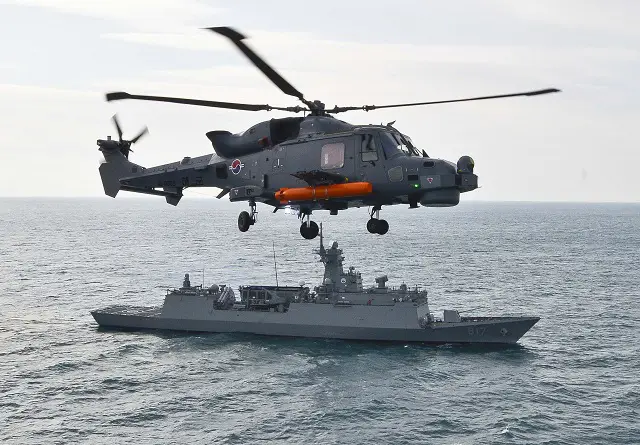 A ROK Navy AW159 Wildcat maritime helicopter conducting an ASW exercise for the first time with Incheon-class frigate Gwangju. Picture: ROK Navy A ROK Navy AW159 Wildcat maritime helicopter conducting an ASW exercise for the first time with Incheon-class frigate Gwangju. Picture: ROK Navy |
|||
|
|
|||
|
According to the ROK Navy the deployment of the Wildcat in operation is expected to further enhance its ability to counter North Korean submarine threats, thereby enhancing its three-dimensional operational capability.
|
|
|
|||
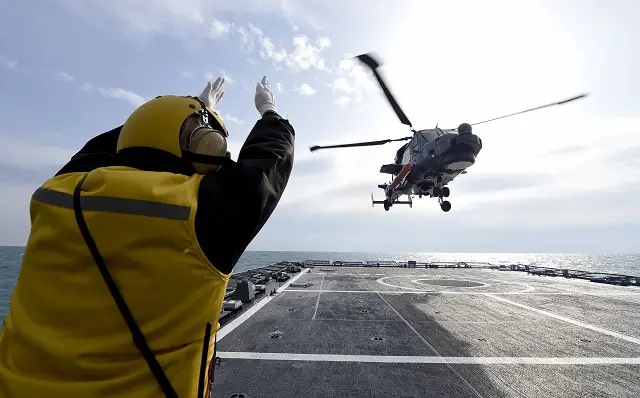 A ROK Navy AW159 Wildcat maritime helicopter conducting an ASW exercise for the first time with Incheon-class frigate Gwangju. Picture: ROK Navy A ROK Navy AW159 Wildcat maritime helicopter conducting an ASW exercise for the first time with Incheon-class frigate Gwangju. Picture: ROK Navy |
|||
|
|
|||
|
The pictures released by the ROK Navy show one Wildact helicopter taking off from Gwangju, stopping at an altitude of 80 feet above the surface of the water to detect underwater submarines. For this, the Wildcat is fitted with a Thales FLASH dipping sonar (active sonar that descends into the water in a suspended state and detects a submarine). It can go down to 300m underwater to detect submarines. During the exercise the dipping sonar started to search for submarine threats by emmiting sound waves for about 9 minutes. When an unidentified underwater object, presumed to be an enemy submarine, was detected by the sonar, the pilot urgently reported the situation to the commanding officer aboard the Frigate.
"Reporting an underwater contact! Classified as an enemy submarine" |
|||
|
|
|||
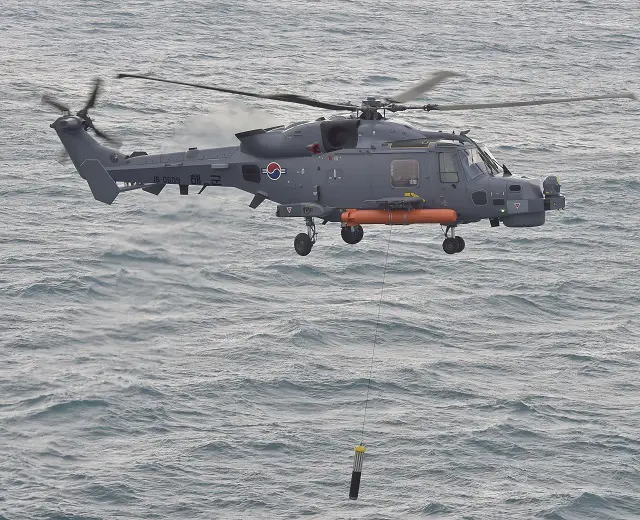 The Wildcat deploying the Thales FLASH dipping sonar The Wildcat deploying the Thales FLASH dipping sonar |
|||
|
|
|||
|
The helicopter then dropped four sonobuoys at the anticipated location of the enemy to determine its exact location. Shortly after, the Wildcat crew received the order to engage. The Wildcat quickly released two training torpedoes.
|
|||
|
|
|||
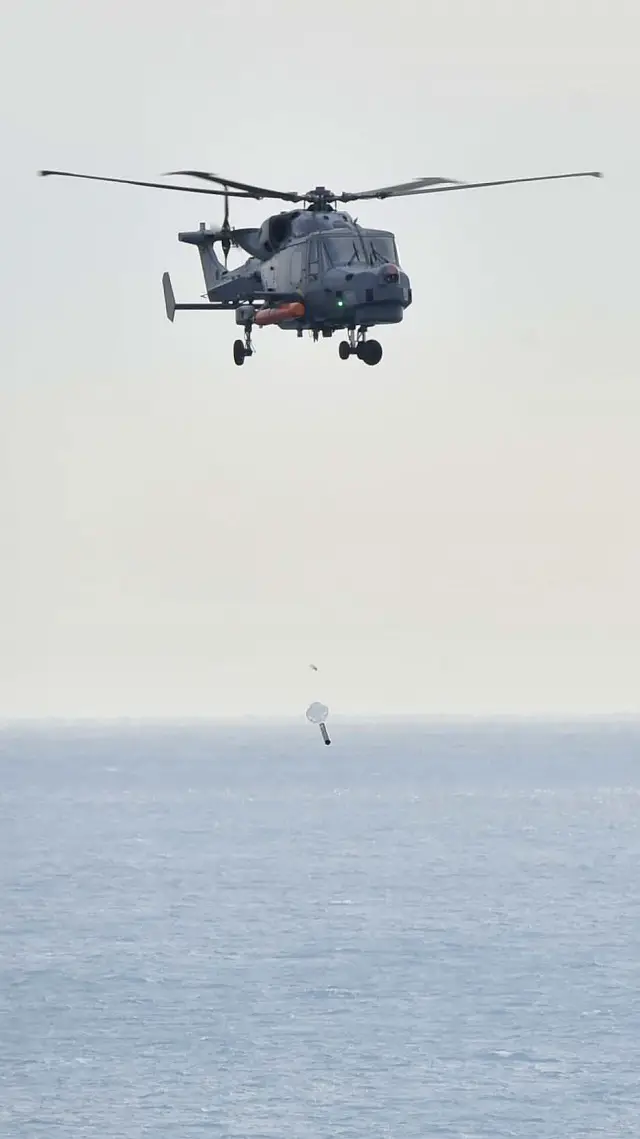 A ROK Navy AW159 Wildcat maritime helicopter conducting an ASW exercise for the first time with Incheon-class frigate Gwangju. Picture: ROK Navy A ROK Navy AW159 Wildcat maritime helicopter conducting an ASW exercise for the first time with Incheon-class frigate Gwangju. Picture: ROK Navy |
|||
|
|
|||
|
The Wildcat involved in the ASW exercise was delivered to the ROK Navy in June last year as part of a batch of four helicopters. The ROK Navy successfully completed the process of forming four Wildcats crews (including pilots, operators, mechanics), conducted day and night flight training, maritime takeoff and landing training, and tactical training, for seven months after the delivery. The remaining four units, which were acquired in December last year, will be used to train pilots and other operational personnel until they become operational in July.
|
|||
|
|
|||
 A ROK Navy AW159 Wildcat maritime helicopter conducting an ASW exercise for the first time with Incheon-class frigate Gwangju. Picture: ROK Navy A ROK Navy AW159 Wildcat maritime helicopter conducting an ASW exercise for the first time with Incheon-class frigate Gwangju. Picture: ROK Navy |
|||
|
|
|||
|
The AW159 is a new generation multi-role military helicopter that is now replacing Lynx helicopters in service with the Royal Navy and British Army. The Wildcat has been ordered by the Philippine Navy as well.
ROK Navy Wildcats are fitted with a Seaspray 7400E radar offering 360 degrees coverage. In January 2014, DAPA announced it will equip its Wildcat helicopters with Spike NLOS missiles to provide a stand-off attack capability for engaging targets such as ground artillery and small vessels. The helicopters are expected to operate from the ROK Navy's Incheon-class guided missile / coastal defense frigates. These will be used for search-and-rescue missions, anti-submarine warfare and surveillance. |
|||
|
|
|||
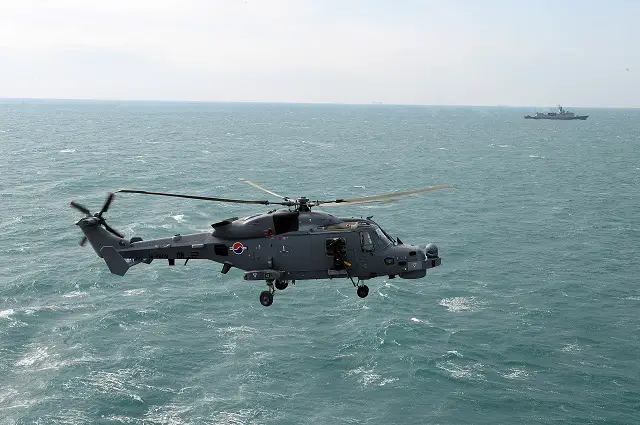 A ROK Navy AW159 Wildcat maritime helicopter conducting an ASW exercise for the first time with Incheon-class frigate Gwangju. Picture: ROK Navy A ROK Navy AW159 Wildcat maritime helicopter conducting an ASW exercise for the first time with Incheon-class frigate Gwangju. Picture: ROK Navy |
|||
|
|
|||
|
According to the ROK Navy, the AESA radar and electro-optic thermal sensor are capable of detecting up to 200 miles (360 km). It is the first time Korea naval aviation that an aircraft ype is equipped with such long-range precision monitoring capability.
Wildcats can operate for more than three hours if equipped with the FLASH dipping sonar alone, two hours if equipped with the dipping sonar and a single "Blue Shark" torpedo, and an hour or more when the dipping sonar and two torpedoes are fitted. According to a ROK naval officer "The naval helicopters such as Wildcat or Lynx can conduct anti-submarine operations in cooperation with the surface vessel and the maritime patrol aircraft (P-3)," he said. "Depending on the situation" "The AW-159's new maritime helicopter is an excellent helicopter with advanced detection equipment and attack weapons against enemy submarines and improved flight capabilities," said Kwak Han-jung, commander of the Wildcat program. "am sure that the enemy who provoke us anywhere in the water will be dealt with on the spot" . |
|||


























